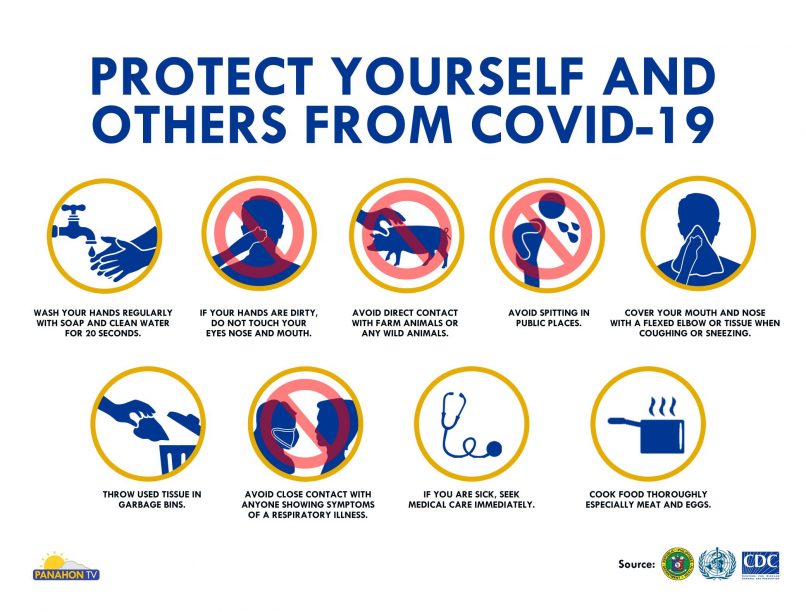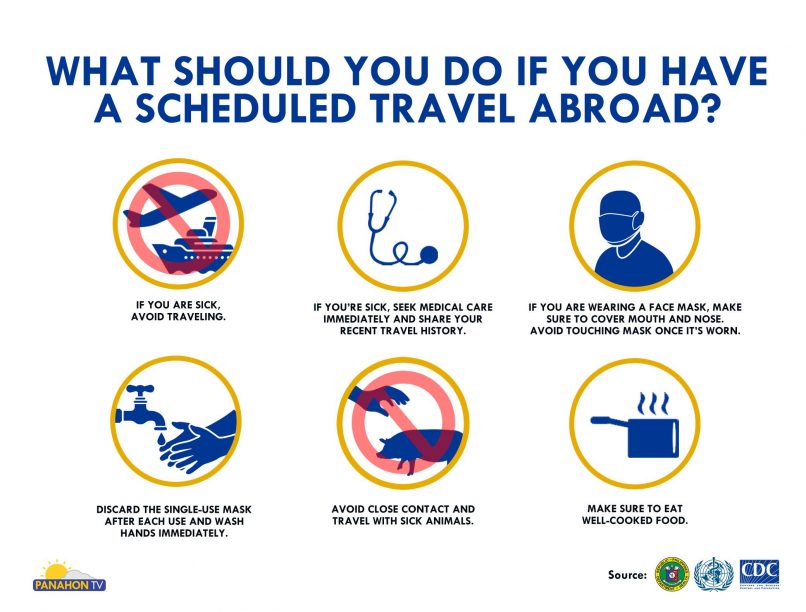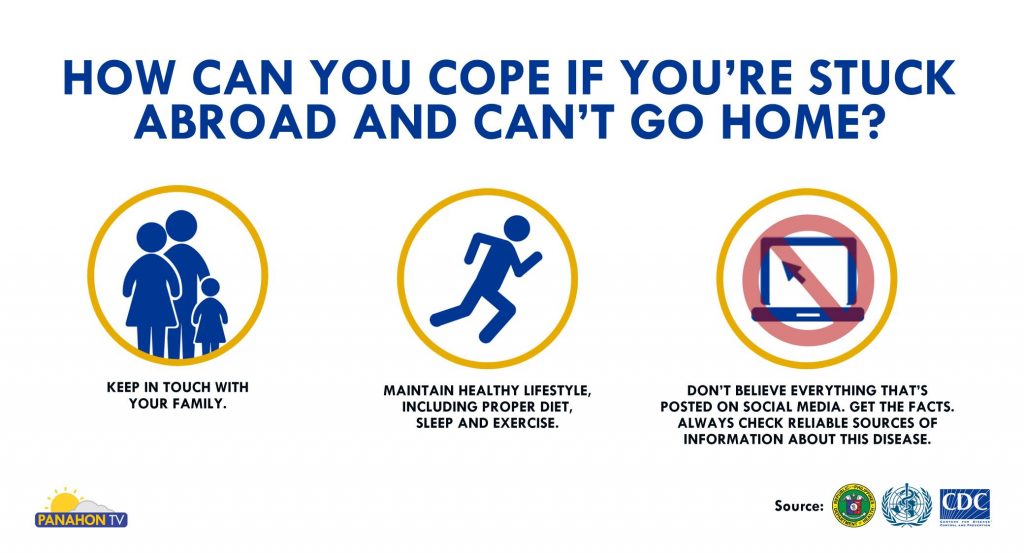- What is coronavirus?
The coronavirus is a type of virus that causes respiratory illness in animals and humans. It is zoonotic, meaning it can be transmitted between animals and humans. The virus was first discovered during the 1960s, and was called coronavirus because of its crown-shaped structure.
As of now, there are seven types of the coronavirus that can infect humans. They range from the common cold to more severe diseases, such as the Middle East Respiratory Syndrome (MERS-CoV), Severe Acute Respiratory Syndrome (SARS-CoV), and its latest strain, the Coronavirus Disease 2019 (COVID-19).
MERS-CoV, discovered in Saudi Arabia last 2012, resulted in 858 deaths. According to scientists, this coronavirus came from camels and has flu-like symptoms. Meanwhile, SARS began in China in 2002. It was reported to have come from a civet cat, and has 8,000 confirmed cases, killing almost 800.
On January 9, 2020, the World Health Organization (WHO) reported a new strain of coronavirus, associated with an outbreak of pneumonia in Wuhan, China. Last February 11, 2020 it was renamed as the Coronavirus Disease-2019 COVID-19.
- Is COVID-19 deadly?
Just like MERS-CoV and SARS, the COVID-19 is deadly. The moment one gets infected, the virus spreads immediately to the lower respiratory tract, including the lungs. This type of coronavirus may cause severe pneumonia in 24 hours, and it cannot be cured by antibiotics.
- What are the symptoms of COVID-19?
Its respiratory symptoms include fever, cough, shortness of breath and other breathing difficulties. However, there are cases of the coronavirus disease that are asymptomatic or display no symptoms. It takes around 14 days before the symptoms appear.
- How can you protect yourself from this virus?
According to the World Health Organization, here are the ways to prevent yourself and others from getting the COVID-19:

- Wash your hands regularly with soap and clean water for 20 seconds.
- If your hands are dirty, do not touch your eyes nose and mouth.
- Avoid direct contact with farm animals or any wild animals.
- Avoid spitting in public places.
- Cover your mouth and nose with a flexed elbow or tissue when coughing or sneezing.
- Throw used tissue in garbage bins.
- Avoid close contact with anyone showing symptoms of a respiratory illness.
- If you are sick, seek medical care immediately.
- Cook food thoroughly especially meat and eggs.
- What should you do if you have a scheduled travel abroad?

- If you are sick, avoid traveling.
- If you’re sick, seek medical care immediately and share your recent travel history.
- If you are wearing a face mask, make sure to cover mouth and nose. Avoid touching mask once it’s worn.
- Discard the single-use mask after each use and wash hands immediately.
- Avoid close contact and travel with sick animals.
- Make sure to eat well-cooked food.
- How can you cope if you’re stuck abroad and can’t go home?

- Keep in touch with your family.
- Maintain healthy lifestyle, including proper diet, sleep and exercise.
- Don’t believe everything that’s posted on social media. Get the facts. Always check reliable sources of information about this disease.
If you need more information, please check these sources:
- Department of Health – https://www.doh.gov.ph/
- World Health Organization – https://www.who.int/
- Centers for Disease Control and Prevention https://www.cdc.gov/
According to the US-based Center for Disease Control and Prevention (CDC), Ebola is a rare and fatal disease caused by infection with a strain of Ebola virus. The fact that the 2014 Ebola epidemic is the largest in history should be enough motivation for everyone to know the basics of the disease.

Ebola explained
Ebola has become a topic of conversation these past few months due to the alarming cases reported all over the globe, especially in numerous West African countries. Various scientists, as well as international and local health organizations, have been doing their best to raise public awareness to help prevent the spread of this malignant disease.
Historically, the first case of Ebola was recorded in 1976, when a young Belgian scientist named Peter Piot travelled to a remote area in Congo to find out the cause of death from an unidentified disease.

The virus was primarily discovered in the Yambuku village but since naming the virus after the village may be deemed as offensive, Piot’s team decided to name it after the nearest river. According to Live Science, one option was the Congo River. However, the Crimean-Congo hemorrhagic fever virus was already in existence.
With the help of a small map, they plotted out the nearest river from Yambuku and that was the Ebola River. Ebola River means “Black River” in Lingala, the language spoken in the Democratic Republic of Congo (DRC).
Symptoms and Transmission
The Ebola Virus Disease or EVD is one of the most virulent viral diseases affecting humankind. It is a viral haemorrhagic fever with symptoms of fever, headache, intense weakness, joint and muscle pains, sore throat, vomiting, diarrhea, stomach pain, impaired kidney and liver functions, and internal and external bleeding. Rash, red eyes, hiccups and bleeding from body openings could occur in some instances.
The Department of Health (DOH) clarified that Ebola cannot be spread through air, water or food. The disease can be transmitted only through direct contact with the body of a deceased person; blood secretions, organ or other bodily fluids of infected animals; and body fluids and stools of an infected person via blood, vomit, pee, poop, sweat, semen or spit. One can also get the virus by using contaminated needles and soiled linen used by infected patients.
Healthcare and laboratory workers who are exposed to secretions and specimens from the patient and family members, or those who are in close contact with the infected individuals, are prone to the virus.
EVD knows no boundaries
Because of the EVD outbreak in West Africa, an area known for its hot and dry climate, some have speculated that it may be a weather-related disease. But according to Dr. Lyndon Lee Suy of the Department of Health-National Center for Disease Prevention and Control (DOH-NCDPC), there is no scientific proof that weather affects the spreading of the Ebola virus. He added that as of now, there are no studies yet on how cold or warm weather stimulates the virus.
According to the CDC, countries with widespread transmission include Guinea, Liberia and Sierra Leone while those with localized transmission are Madrid, Spain; Dallas, Texas and New York City, New York in United States. Mali in West Africa was affected with travel-associated cases.
Meanwhile, Nigeria and Dakar, Senegal were already declared Ebola-free by the World Health Organization (WHO).
Based on WHO’s report, more than 10,000 confirmed, probable and suspected cases of EVD have been reported in Guinea, Liberia, Mali, Sierra Leone, Spain and United States of America. Out of this number, nearly 5,000 patients have been reported dead.
Table: Chronology of previous Ebola virus disease outbreaks

Actions taken in the PH
In a press release of DOH dated on October 17, 2014, the department stated that it will conduct specialized training programs to raise awareness and response to EVD. With the help of WHO, the programs aim to deepen the understanding of health workers on the detection and treatment of EVD cases and to stop the infectious disease from spreading.
The training programs started on October 28 when Dr. Lyndon Lee Suy led the “Training on Hospital Management of Ebola Virus Disease” held at the Research Institute for Tropical Medicine in Alabang, Muntinlupa.
Sources:
Department of Health
World Health Organization
Center for Disease Control and Prevention
Live Science
http://www.bbc.com/news/magazine-28262541

